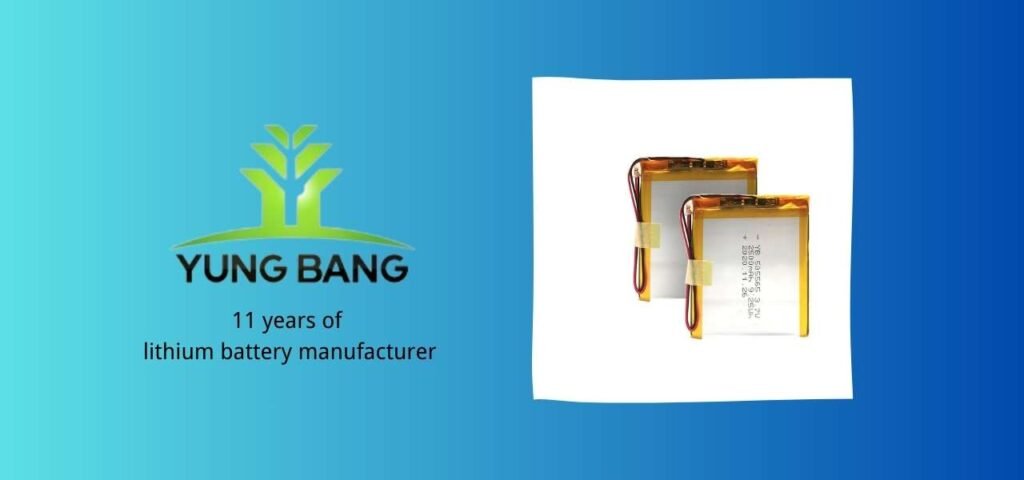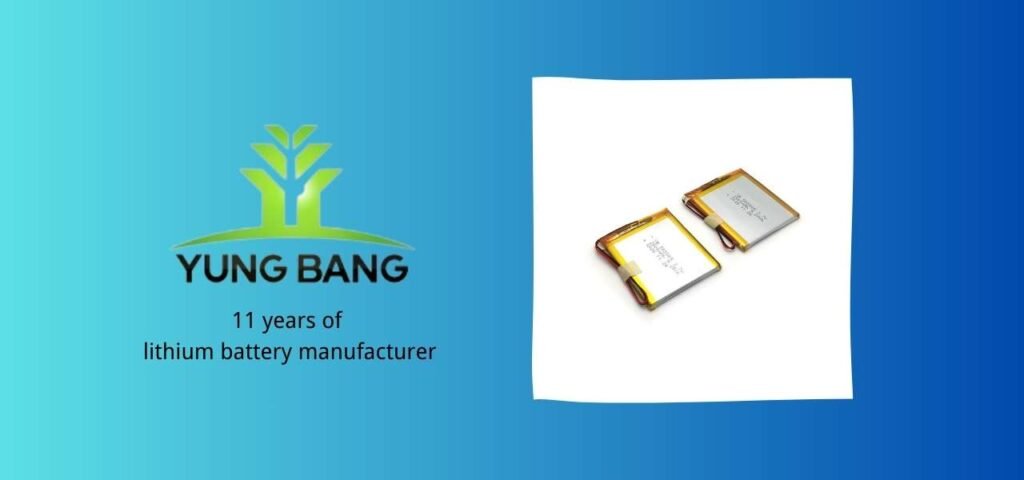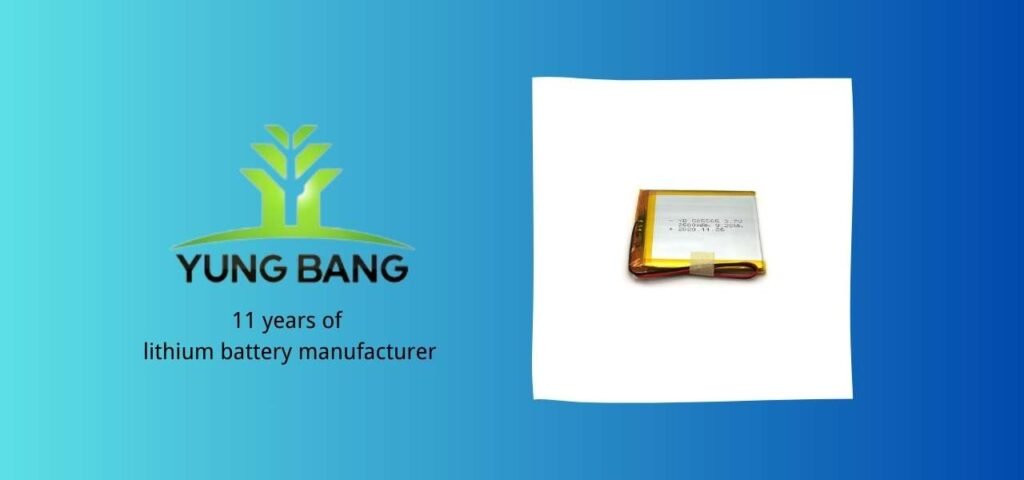1.What is a battery li-polymer 3.7V?
“Battery Li-Polymer 3.7V” refers to a type of lithium polymer battery with a rated voltage of 3.7 volts. Here is some information about this type of battery:
Chemical Composition: Lithium polymer batteries utilize lithium-ion technology, but unlike traditional lithium-ion batteries, they use a polymer electrolyte instead of a liquid electrolyte. This design makes lithium polymer batteries thinner and more versatile in shape while providing higher safety performance.
Rated Voltage: The rated voltage of lithium polymer batteries is typically 3.7 volts. This is the average voltage of the battery during charging and discharging.
Capacidad: Battery capacity is usually measured in milliampere-hours (mAh), indicating the amount of charge the battery can store. Higher capacity means longer operating time.
Aplicaciones: This type of battery is widely used in various electronic and portable devices such as smartphones, tablets, portable audio devices, drones, and electric toys.
Size and Form: Lithium polymer batteries can be manufactured in various shapes, making their size and shape customizable according to specific applications. They are typically thin and lightweight, suitable for space-constrained or lightweight designs.
Charging and Discharging Characteristics: Compared to other types of lithium batteries, lithium polymer batteries have lower internal resistance and higher discharge rates, thus offering higher power density.
Seguridad: Lithium polymer batteries generally have higher safety performance and are less prone to thermal runaway or explosions compared to other types of lithium batteries.
In summary, Battery Li-Polymer 3.7V is a type of lithium battery that is thin, safe, and suitable for various portable devices.

2.What is the typical capacity of a battery li-polymer 3.7V?
The typical capacity of a Battery Li-Polymer 3.7V can vary depending on the battery’s size, design, and manufacturing process, so there is no fixed standard capacity. However, generally speaking, common Li-Polymer 3.7V battery capacities range from a few hundred milliampere-hours (mAh) to several thousand milliampere-hours (mAh), depending on specific applications and requirements.
For common portable devices such as smartphones, tablets, and portable audio devices, the capacity of Battery Li-Polymer 3.7V typically ranges from 1000mAh to 4000mAh. Such capacities can meet the needs of most portable devices and provide longer usage times.
For applications requiring higher capacity, such as power tools, aviation models, and drones, larger capacity Li-Polymer 3.7V batteries may be used, with capacities reaching several thousand milliampere-hours (mAh) or higher.
Therefore, the universal capacity of Battery Li-Polymer 3.7V can vary depending on specific applications and requirements, and choosing the appropriate capacity depends on the device’s power consumption and expected usage time.
3.What is the general size of a battery li-polymer 3.7V?
The general size of a Battery Li-Polymer 3.7V can vary depending on the specific design and manufacturing process, so there is no fixed standard size. However, as a general guide, common Li-Polymer 3.7V battery sizes typically fall within the following ranges:
Length: Usually between 40 millimeters to 150 millimeters.
Anchura: Typically between 20 millimeters to 60 millimeters.
Grosor: Generally between 3 millimeters to 10 millimeters.
These sizes depend on the battery’s capacity, design, and manufacturing process. Smaller batteries are typically used in portable devices such as smartphones and tablets, while larger batteries are used in larger devices such as power tools and drones.
4.What is the general weight of a battery li-polymer 3.7V?
The general weight of a Battery Li-Polymer 3.7V can vary depending on the specific design, capacity, and manufacturing process, so there is no fixed standard weight. However, as a general guideline, common Li-Polymer 3.7V battery weights typically fall within the following ranges:
Small batteries: Usually between 5 grams to 20 grams.
Medium-sized batteries: Typically between 20 grams to 50 grams.
Large batteries: Generally between 50 grams to 150 grams.
These weight ranges are estimated based on common battery capacities and sizes, and the specific weight depends on the battery’s internal construction, casing materials, and other factors.

5.What is the nominal voltage and charging voltage range of a battery li-polymer 3.7V?
The nominal voltage and charging voltage range of a Battery Li-Polymer 3.7V are as follows:
Nominal Voltage: The nominal voltage of Battery Li-Polymer 3.7V is typically 3.7 volts. This is the rated voltage of the battery during normal operation, indicating the average voltage of the battery. In practice, the voltage of lithium polymer batteries fluctuates slightly during charging and discharging, being slightly higher during charging and slightly lower during discharging.
Charging Voltage Range: The charging voltage range of Battery Li-Polymer 3.7V is typically around 4.2 volts. During the charging process, the battery voltage gradually increases from its open circuit voltage (OCV) to the charging termination voltage. The charging termination voltage is usually set around 4.2 volts because lithium polymer batteries are considered fully charged at this voltage, and any higher voltage may lead to overcharging and safety issues. Therefore, during charging, the charging voltage should be controlled within the range of 3.7 volts to 4.2 volts.
6.What is the general cycle life of a battery li-polymer 3.7V?
The general cycle life of Battery Li-Polymer 3.7V depends on several factors, including manufacturing quality, charging and discharging environment, charging and discharging rate, depth of discharge, and usage and storage conditions. Generally, the cycle life of lithium polymer batteries ranges from several hundred to several thousand cycles.
Factors affecting cycle life include:
Manufacturing Quality: The manufacturing quality of the battery significantly affects its cycle life. High-quality batteries typically have longer cycle lives.
Charging and Discharging Environment: Factors such as temperature, humidity, and air pressure in the charging and discharging environment can affect the battery’s life.
Charging and Discharging Rate: Excessive charging and discharging rates can accelerate battery aging, reducing its cycle life. Controlling the charging and discharging rate appropriately can extend the battery’s life.
Depth of Discharge: Deep charging and discharging cycles can shorten the battery’s life. It is recommended to avoid fully charging or fully discharging the battery.
Usage and Storage Conditions: Proper usage and storage conditions contribute to prolonging the battery’s life. Avoiding prolonged exposure to high temperatures, low temperatures, or humidity is essential.
7.What are the typical protection measures of a battery li-polymer 3.7V?
Battery Li-Polymer 3.7V typically incorporates several protection measures to ensure safety and performance stability. Some common protection measures include:
Overcharge Protection: The battery’s built-in circuit detects and prevents overcharging by stopping charging when the battery reaches a set charging termination voltage.
Overdischarge Protection: The battery’s built-in circuit detects and prevents overdischarge by stopping discharging when the battery voltage drops below a safe threshold.
Overcurrent Protection: The battery’s built-in circuit detects and prevents overcurrent by stopping discharging when the battery’s output current exceeds a set safety threshold.
Short Circuit Protection: The battery’s built-in circuit detects and prevents short circuits by immediately stopping discharging when the battery’s positive and negative terminals are directly connected.
Temperature Protection: The battery’s built-in circuit monitors and responds to changes in battery temperature. When the battery temperature exceeds a set safety threshold, the battery circuit stops discharging or charging to prevent overheating or fires.

8.What is the normal production process of a battery li-polymer 3.7V?
The normal production process of Battery Li-Polymer 3.7V involves several steps:
Raw Material Preparation: Prepare the raw materials required for lithium-ion battery production, including lithium salts, polymer electrolytes, anode materials (such as graphite), cathode materials (such as cobalt oxide or lithium iron phosphate), conductive agents, and binders.
Battery Material Preparation: Mix the anode material and cathode material separately with conductive agents and binders to form anode slurry and cathode slurry. Then coat the slurry onto current collectors, which are then pressed and cut to form anode and cathode sheets.
Electrolyte Preparation: Prepare the polymer electrolyte solution, typically by dissolving the polymer in an organic solvent to form the polymer electrolyte solution.
Battery Assembly: In a clean room environment, stack the anode sheets, cathode sheets, and polymer electrolyte layers in a certain sequence to form a wound cell structure. Meanwhile, connect current collectors to the positive and negative terminals of the battery as the positive and negative outputs.
Sealing and Injection: Place the assembled battery into aluminum foil bags or aluminum-plastic films, seal the bags by heat sealing, and inject the electrolyte into the bags to ensure complete impregnation of the electrolyte between the electrodes.
Final Testing: Conduct rigorous testing on the finished batteries, including visual inspection, electrical performance testing, safety performance testing, etc., to ensure that each battery meets specified standards and requirements.
Packaging and Packaging: Place the tested batteries into packaging boxes and label them with battery model, specifications, production date, etc. Then seal and package the boxes for shipment or sale.
9.About Yungbang’s Battery Li-Polymer 3.7V Products
Official Website: Yungbang may provide detailed information about its product range, including Battery Li-Polymer 3.7V products’ specifications, performance, applications, etc., on its official website.
Contact the Manufacturer: You can directly contact Yungbang or its authorized agents to inquire about detailed information regarding their Battery Li-Polymer 3.7V products.
10.Introduction to Yungbang Battery Factory
Guangdong Yungbang New Energy Co. was established in June 2013. Currently, we have a factory covering an area of 18,000 square meters and employ over 500 staff members. We possess multiple independent intellectual property rights and are recognized as a national high-tech enterprise specializing in the research, development, design, production, and sales of lithium-ion battery cells and battery packs.
